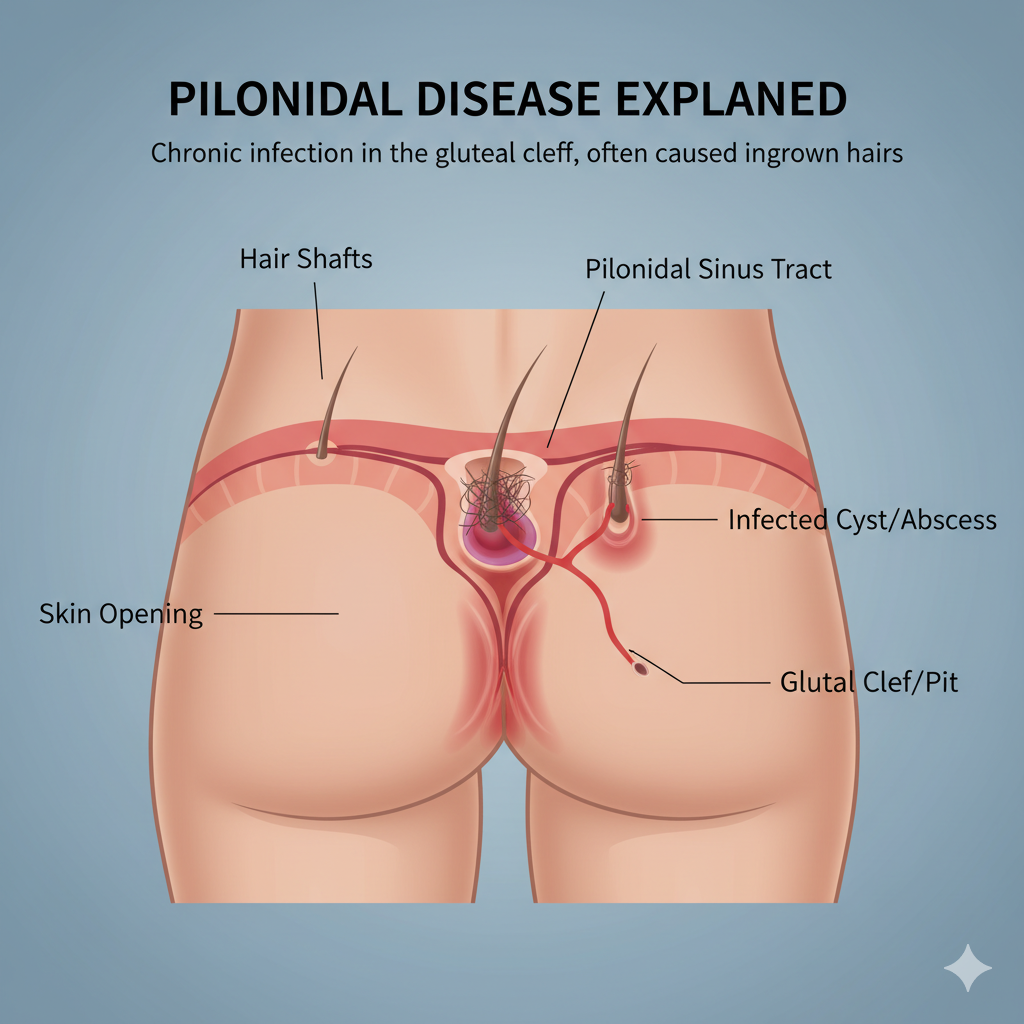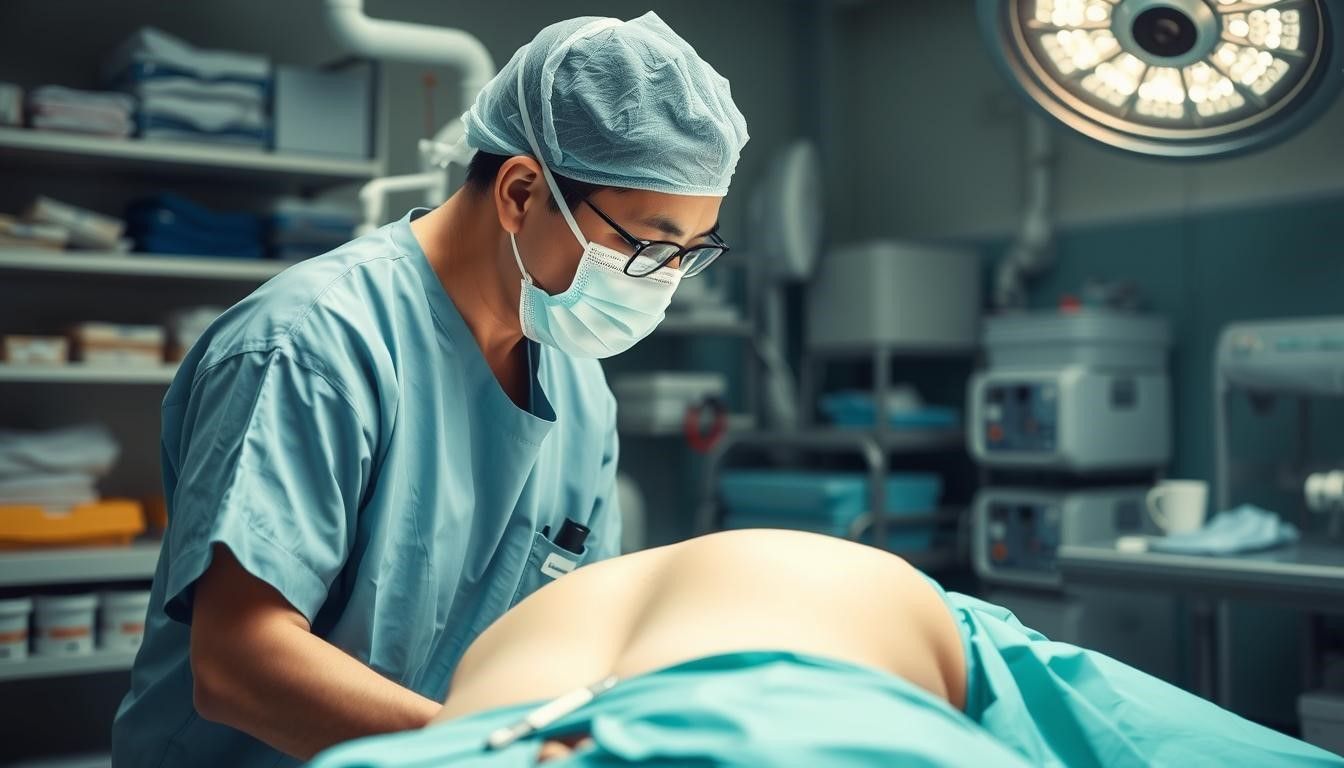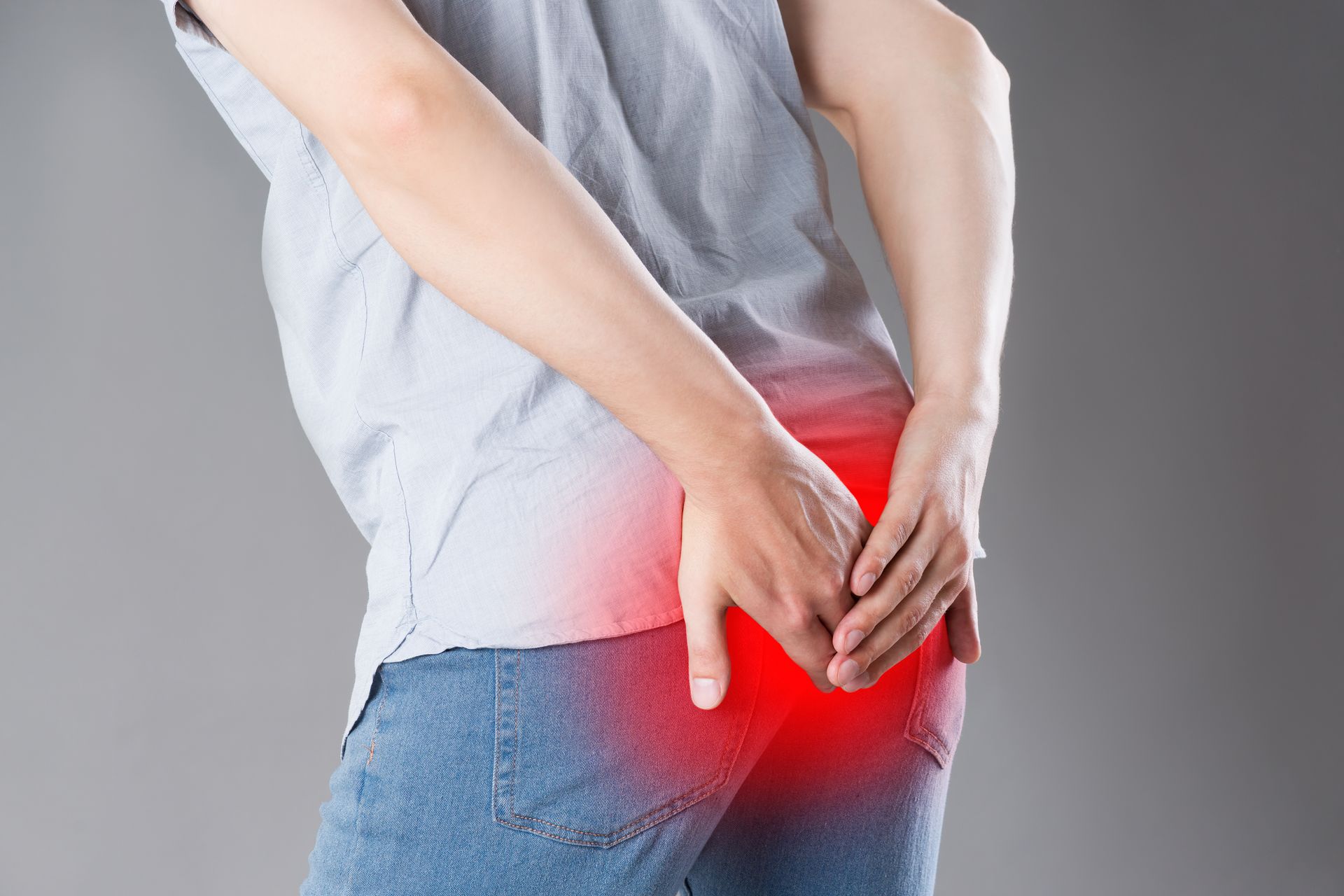What is Pilonidal Disease? The Basics from Pilonidal Fix
Pilonidal disease affects the crease near the tailbone. A pilonidal cyst forms under the skin in that buttock crease when hair and debris get trapped in tiny pits. This can lead to pain, swelling, drainage, and sometimes fever above 101.3°F (38.5°C).
More than 70,000 cases occur in the United States each year. While not life‑threatening, the condition can turn chronic without prompt care. Teens and young adults, especially males, develop the problem more often due to hair growth and friction in the area.

Treatment ranges from urgent incision and drainage for an abscess to minimally invasive pit picking and larger procedures like the cleft lift for complex disease. Laser hair removal—typically 4–7 sessions spaced 6–8 weeks apart—helps lower recurrence.
Pilonidal Fix is the only dedicated practice in the Northeastern United States focused exclusively on this condition. Led by New Jersey specialist Dr. Rafailov, the team offers clear guidance, compassionate care, and high cure rates. Visit www.pilofix.com or call 973-323-2400 for same‑week help.
Key Takeaways
- A pilonidal cyst sits under the skin in the buttock crease and often starts when hair and debris burrow into skin pits.
- Watch for pain, redness, swelling, drainage, and fever; quick evaluation prevents chronic issues.
- Treatments range from incision and drainage to pit picking and cleft lift for complex cases.
- Laser hair removal in several sessions reduces recurrence and supports long‑term healing.
- Pilonidal Fix, led by Dr. Rafailov, provides focused care and fast answers in the Northeastern U.S.
What is Pilonidal Disease
Small pits in the gluteal cleft can start a chain reaction that leads to larger, painful lumps beneath the skin.
Simple definition: cysts, sinuses, and abscesses
Pilonidal disease describes a process in the buttock crease where tiny openings trap hair and debris. Those pits may form a cyst—a sac under the skin that can fill with fluid or pus.
How trapped hair and debris create pits and infection
Loose hair works like a splinter. Friction and moisture push hair into the pit and the skin reacts. That reaction can lead to a painful skin infection or an abscess that needs urgent care.
Types and common misconceptions
Terms you may hear include pilonidal cyst, pilonidal sinus (a small tunnel), and abscess. These are stages along the same spectrum.
It’s not just a pimple. Left untreated, the problem can become chronic and involve multiple tracts. Pilonidal Fix evaluates pits and sinus tracts and suggests targeted, minimally invasive options to stop recurrence.
Who Gets Pilonidal Disease and Why
Teens and young adults make up most new cases, with males affected more often due to heavier hair growth and anatomy changes during this age range.
Risk factors include a deep buttock crease, abundant body hair, excess sweating, higher body mass, and a family history that suggests genetic tendency.
Long periods of sitting increase pressure and friction in the crease buttocks. That motion helps hair push into tiny skin pits and can start a pilonidal cyst or multiple sinus tracts.
Small lifestyle changes make a difference. Wearing breathable fabrics, drying the area after activity, and managing hair reduce irritation and lower flare risk.
- This common condition appears most often in the teen to young adult age group and is seen more in males.
- Family history and body mechanics can influence who develops pilonidal cysts.
- Recognizing personal triggers helps with prevention and timely care.
Pilonidal Fix educates patients and families so they can adopt proactive habits and seek evaluation early. For personalized guidance in New Jersey, visit www.pilofix.com or call 973-323-2400.
Symptoms and When to Seek Care
Early symptoms: Early signs often begin as a small, tender spot at the top of the buttock crease. That spot may swell, redden, and hurt when you sit. Track changes so you notice if it gets worse.
Early warning signs
Localized pain, mild swelling, and tenderness near the tailbone are common first clues. You might think it’s a bruise at first. If the soreness persists or the area drains, get evaluated.
Signs an abscess is forming
An abscess becomes firm, warm, and very painful. It may drain pus or blood and smell foul. Incision and drainage often ease pressure and pain quickly.
Red flags — call a specialist
Seek urgent care for fever over 101.3°F, severe pain, or if you cannot sit. These signs suggest the condition gets worse and may need prompt procedure and follow-up.
- Early: tender spot, mild redness, soreness when sitting.
- Progression: increased heat, swelling, spotting of blood or clear drainage.
- Abscess: firm painful lump that may drain pus; needs drainage.
- Red flags: fever, chills, severe pain, or inability to sit — contact Pilonidal Fix at 973-323-2400 or visit www.pilofix.com.
Diagnosis and Evidence‑Based Treatment Options
Accurate diagnosis starts with a focused history and a careful exam to map pits, cysts, and any sinus tracts. Finding the exact source guides the right level of care and reduces the chance the problem keeps coming back.
How we diagnose
We ask targeted questions and perform a gentle exam to locate pits and any active cyst or abscess. Mapping these tracks helps decide if you need urgent relief or a longer course.
Acute relief and definitive options
For a painful pilonidal abscess, incision and drainage often provide fast relief under local anesthesia. Drainage alone doesn’t cure the disease; once infection eases, we reassess for definitive care.
Definitive procedures include pit picking for limited problems, excision of chronic sinus tracts, phenol in select cases, and cleft lift for recurrent or complex patterns. Some cases may require flap techniques for durable results.
Hair management, home care, and goals
Hair removal through laser—typically 4–7 sessions spaced 6–8 weeks—cuts recurrence compared with shaving. At home, keep the area dry, remove lint and hairs, and avoid long sitting to protect skin and wound healing.
- Goal: quick pain control, faster healing, and fewer recurrences.
- At Pilonidal Fix, Dr. Rafailov reviews findings with you and outlines realistic recovery and wound care so you know what to expect.
For appointments, call 973-323-2400 or visit www.pilofix.com. We explain options plainly and help you choose the best treatment plan.
Why Choose Pilonidal Fix in New Jersey
A focused clinic that treats only this condition can speed diagnosis and improve outcomes. Pilonidal Fix is the only dedicated practice in the Northeastern U.S., offering concentrated experience for lasting recovery.
Comprehensive care with high cure rates and minimally invasive options
We prioritize minimally invasive steps when they suit your anatomy. Many cases respond to pit picking and targeted excision, while complex or chronic pilonidal patterns may require cleft‑flattening or flap techniques.
Direct access to Dr. Rafailov, clear communication, and honest guidance
You’ll speak directly with Dr. Rafailov for a clear plan that starts with symptom control and moves to a durable fix. Expect plain explanations, photos or diagrams when needed, and steady follow-up.
Call 973-323-2400 or visit www.pilofix.com to schedule care today
We integrate hair removal into treatment plans because laser hair removal reduces recurrence and protects results. For stubborn or chronic pilonidal disease, individualized strategies stop the problem from coming back.
- Exclusive focus on this disease means faster, smarter decisions for imaging and procedure choice.
- Clear pathway from urgent relief to definitive treatment and long‑term hair control.
- Friendly scheduling, quick answers, and a team that welcomes second opinions.
Conclusion
If you or a teen has ongoing pain, swelling, or drainage in the buttock crease, early care makes a big difference.
Pilonidal disease often starts with small pits that trap hair and form cysts. Quick evaluation can stop repeated infections and avoid abscesses that need urgent drainage.
At Pilonidal Fix we map the source, explain options from pit picking to cleft‑flattening, and include hair removal strategies to protect results. Our goal is a durable cure and fewer wound setbacks.
For fast answers and a clear plan, call 973-323-2400 or visit www.pilofix.com to schedule with Dr. Rafailov, New Jersey’s pilonidal specialist.
Frequently Asked Questions About Pilonidal Disease
What is Pilonidal Disease? The Basics from Pilonidal Fix
A condition that forms cysts, sinuses, or abscesses in the crease between the buttocks. It happens when hair and skin debris lodge in small pits, causing inflammation and sometimes infection. It can range from a single painful lump to chronic draining tracts that recur without proper care.
Simple definition: cysts, sinuses, and abscesses in the buttock crease
A cyst is a closed sac under the skin, a sinus is a small channel that can drain, and an abscess is a pus-filled, painful lump. All can appear near the tailbone and may require different treatments depending on severity and chronicity.
How trapped hair and skin debris create pilonidal pits and infection
Loose hairs and dead skin collect in the gluteal cleft. Friction and movement push material into tiny pits. The body treats that debris as foreign, triggers inflammation, and bacteria can multiply, producing an infected abscess or sinus.
Types you may hear about: pilonidal cyst, pilonidal sinus, pilonidal abscess
Cysts are non-draining pockets, sinuses are draining tracts often with multiple openings, and abscesses are acute, painful infections that usually require urgent drainage. Chronic cases can include a mix of these findings.
Common misconceptions: it’s not “just a pimple” and it can become chronic
Small lumps near the tailbone might look like pimples but can worsen quickly. Recurrent problems often need surgical options to remove tracts and prevent return. Early treatment lowers the chance of chronic disease.
Typical age and sex patterns: teens to young adults, more common in males
Most cases occur between puberty and the mid-30s, when hair is thicker and activity levels are high. Men get this more often than women, though anyone with risk factors can develop it.
Risk factors: deep buttock crease, body hair, sweating, obesity, family history
A deep cleft, dense body hair, frequent sweating, excess weight, and a family tendency raise risk. These factors increase friction and trapping of hair in skin pits, promoting inflammation and infection.
Lifestyle triggers: prolonged sitting, friction, and moisture in the gluteal cleft
Jobs or habits that involve long periods of sitting, tight clothing, and activities that cause constant rubbing can worsen or trigger symptoms. Keeping the area dry and reducing friction helps prevention.
Early symptoms: pain, redness, swelling, tenderness near the tailbone
At first you may notice a tender bump, warmth, or redness near the top of the crease. Mild pain while sitting or standing and occasional drainage can follow as inflammation progresses.
Signs of an abscess: warmth, drainage of pus or blood, increasing pain
Ahot, swollen, very painful lump that leaks pus or blood usually means an abscess. Fever and severe discomfort are common and often require prompt medical attention for drainage and antibiotics.
Red flags: fever, severe pain, difficulty sitting—time to call a specialist
If you develop fever, spreading redness, intense pain, or can’t sit comfortably, seek care quickly. These signs suggest a progressing infection that may need urgent incision and drainage or other procedures.
How we diagnose: history, physical exam, identifying pits and sinus tracts
Clinicians diagnose by asking about symptoms and examining the crease for pits, swelling, drainage, or sinus openings. Imaging is rarely needed unless the picture is unclear or deep tracts are suspected.
Acute relief: incision and drainage for a pilonidal abscess
For an infected abscess, a minor procedure to drain pus provides fast pain relief and controls infection. Follow-up cares for the wound and plans definitive treatment when needed to prevent recurrence.
Definitive care for chronic sinus disease: pit picking, excision, cleft lift
Minimally invasive pit picking removes surface tracts. Excision removes diseased tissue. The cleft lift reshapes the cleft to reduce hair trapping and friction. Choice depends on disease extent and patient goals.
Laser hair removal to reduce recurrence and keep the area hair‑free
Targeted laser treatments reduce hair density in the cleft, lowering the chance hairs cause new pits. Used alongside surgical care, laser hair removal can cut recurrence rates and ease long-term maintenance.
Home care and prevention: hygiene, keeping the crease dry, reducing friction
Regular cleaning, drying the area after bathing, avoiding tight clothing, and removing nearby hair help. After minor procedures, wound care and activity adjustments speed healing and reduce relapse risk.
Goals of treatment: pain control, faster healing, fewer recurrences
Effective care relieves pain quickly, promotes durable healing, and minimizes the chance the condition returns. Treatment plans balance fast recovery with long-term success for each person.
Comprehensive care with high cure rates and minimally invasive options
Specialized centers offer tailored care, from drainages and pit picking to cleft lifts and laser hair removal. Minimally invasive approaches often shorten recovery while maintaining strong cure outcomes.
Direct access to Dr. Rafailov, clear communication, and honest guidance
Patients benefit from direct consultation with experienced surgeons who explain options, risks, and expected recoveries. Clear guidance helps choose the best path for acute or chronic conditions.
Call 973-323-2400 or visit www.pilofix.com to schedule care today
If symptoms match those described or you’ve had repeat problems, contact the clinic for evaluation and personalized treatment planning. Early expert care often avoids prolonged issues and repeated infections.





